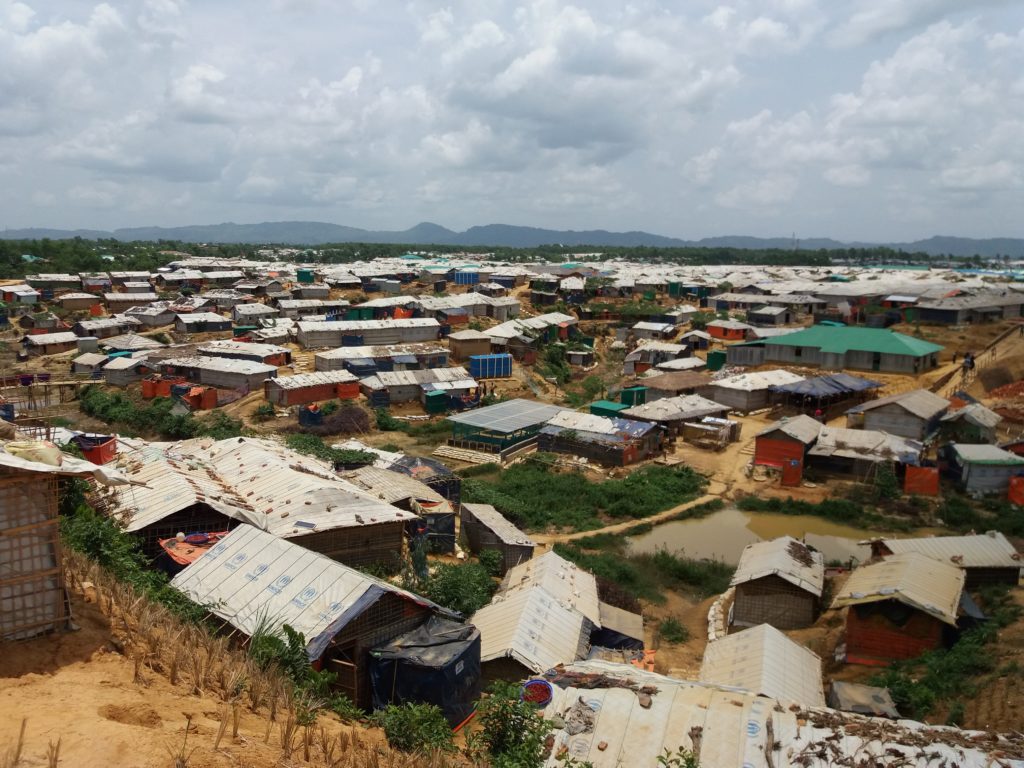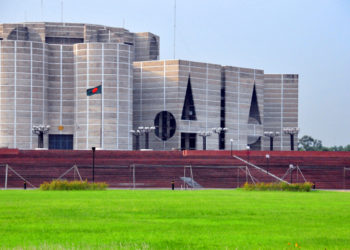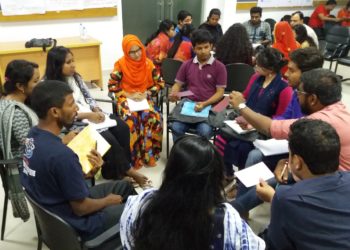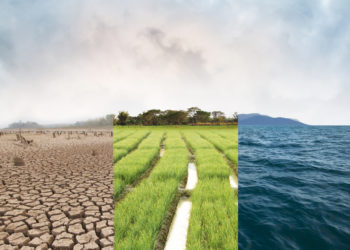Bangladesh is now hosting more than 859,000 Rohingyas — the ethnic Muslim minority of Myanmar — at 34 refugee camps on its southeastern Cox’s Bazar-Teknaf peninsula. Between 25 August and 31 December 2017, over 723,000 Rohingyas entered Bangladesh to save themselves from genocide in Myanmar. These people are staying in camps created by clearing 2,500 hectares of forestland. The Government of Bangladesh, donors, UN agencies, and national and international NGOs are collectively managing this unmeasurable humanitarian crisis.
The challenges around this crisis are multi-dimensional and complex — fulfilling refugees’ everyday basic needs, protecting them from illegal exploitation, ensuring the future of the 55% who are children, saving them from epidemics and pandemics, reducing potential tension between the Rohingya refugees and the Bangladeshi hosts, and tackling geopolitics around this crisis to name but a few. To researchers, this crisis gives a tremendous opportunity to explore the situations, explain the challenges, test ideas and innovations, recommend solutions, and evaluate actions.
But academic research takes time. Response to humanitarian emergencies like a refugee crisis, on the other hand, is all about urgent action. Here a delay can be a question of life or death. Refugee crises thus demand actions based upon past experiences — what worked and what could work given certain factors within a specific context and ground reality.

Once the emergency phase of a refugee crisis is over, there comes a phase that needs to maintain the support system already in place and improve it as much as possible. While the negotiations to resolve the crisis go on, there might now be time to take a breath to reflect on and look into the overall situation. There might be time to see things holistically, how one action affects the other, gather evidence, and act upon the new knowledge.
As we are now in the 32nd month of the Rohingya refugee crisis in Bangladesh, I am wondering — what is the overall situation of academic research and publishing on this refugee crisis? I particularly want to know, who is conducting and publishing research, if any; where they are from; what subjects they are researching; where do they publish their results; if these are accessible; and where Bangladeshi researchers and journals stand in all this.
Although my questions are around Bangladesh’s refugee crisis, the answers could be useful for other countries around the world, altogether harboring 26 million refugees. The analysis may give us lessons and insights not only into the communication of research into the refugee crisis, but also the findings of the research itself.
How much scholarly publishing is there on Bangladesh’s refugee crisis?
To find answers to the above questions, on 25 March, 2020, using some of my self-quarantined time in Dhaka, I searched titles on Google Scholar using the keywords “Rohingya refugee” and “Rohingya refugees”, starting from 2018. Out of a total of 184 documents, I found 47 on Bangladesh’s Rohingya refugee crisis and included them in my assessment. These mostly include peer-reviewed research articles and several field reports in medical journals and a systemic review. The documents I left out either were not on Bangladesh’s Rohingya refugees or were unpublished master’s theses, commentaries, comments, correspondences, book chapters, conference papers, editorials, working papers, policy briefs, organizational research reports, or review papers. I believe, there are likely more journal articles on Bangladesh’s refugee crisis than this initial search produced. In this quick analysis, however, I assumed that, since the ongoing Rohingya refugee crisis is a relatively new research area, authors would have used my search words in their paper titles. So, the selected 47 articles should cover a significant portion of published papers on this refugee crisis.
Although 47 is not a large number, the scholarly literature on the Rohingya refugee crisis is gradually increasing. In 2018, the publication rate was 0.67 paper per month; in 2019 it increased to 2.17 papers per month. In the first months of 2020, the rate reached 4.64 papers per month.
A total of 26 publishers published 37 titles where the 47 papers were published — one medical journal published 11 papers in a special issue on the Rohingya refugee crisis. Most of the publishers are large — BMJ, Elsevier, MDPI, Oxford University Press, PLOS, Sage, Springer Nature, and Taylor & Francis; but the list also include relatively small publishers. There are eight journals that are published by societies or universities or are publicly funded. Only one of the journals is published by a Bangladeshi learned society. Out of the 47 papers, 39 are open access.
Where do the researchers come from?
It was difficult to determine the nationality of the authors. Many authors with names common in Bangladesh mentioned only their foreign host institutions as their sole address, while many authors with western or non-Bangladeshi names used their organizational addresses, in many cases located in Cox’s Bazar. Because of this, I analyzed the countries of authors’ affiliated institutions or organizations. On a few occasions, authors gave multiple addresses; in those cases, I considered the first address or the corresponding address.
A total of 175 authors wrote the 47 papers. Of them, seven authors co-authored multiple, up to four, papers. Out of 47 papers, 25 papers had Bangladesh-affiliated authors as the first or sole author.
In terms of author composition in a paper, 38% of the papers have all authors from Bangladesh-affiliated organizations. Around 19% papers have more than half and 11% have less than half Bangladesh-affiliated authors. Authors of 15 papers (32%) show no Bangladeshi connection.
Besides Bangladesh, 88 authors are from 16 countries, including USA (28 authors), Australia (13), UK (12), Japan (8), Denmark (7), Switzerland (5), Canada (3), France, Malaysia and Saudi Arabia (2 each), and China, India, Iraq, Kenya, Nepal and Papua New Guinea (1 each).
What subjects do they research?
Most research papers (25 out of 47) are on health-related issues, mainly covering mental health, infectious diseases, child & maternal health, health services, and public health. These are obvious choices given the huge health-related challenges the refugee crisis has brought in and because people are staying in extremely congested settlements. Mental health research dominates due to a special issue published by the journal Intervention in November, 2019 on the mental health and psychosocial wellbeing of Rohingya refugees.
Insight into the health challenges of refugee communities remains particularly important in light of the on-going coronavirus pandemic. While the rest of us are widely practicing hand-washing and self-isolation, the vulnerability of refugee communities has increased enormously as many lack ready access to water and soap and the scope for self-quarantine.
Other research areas covered by the 47 papers include social science and humanities subjects such as human rights, gender, humanitarian crisis, economics, politics, and history, as well as other areas including media & journalism, disaster management, forestry, wildlife, and energy.
There are some interesting research topics. One piece of research was published by a team of computer scientists from Bangladesh, where they used machine learning to estimate refugee population in the camps. Another Bangladeshi team used a similar technology to predict landslide impacts on the refugee camps’ infrastructures. Published in January this year, a paper in the journal Energy describes a hybrid energy system that uses solar and wind energy sources that was tried for the first time in Bangladesh’s refugee camp. Its first three authors are from three different Bangladeshi institutions; the other four are from India, Malaysia, and Saudi Arabia — showing a good scholarly collaboration among the Global South countries.
Does a refugee crisis need research?
There is a very strong data collection, analysis and management system which effectively supports Rohingya refugee camp management in Bangladesh (check out the UNHCR’s Operational Portal as an example). There is therefore a limited scope for academic research offering support to this highly specialized, fast-paced, huge operation. Of course, no research on the Rohingya refugee crisis in Bangladesh, especially with the refugees, is possible without direct or indirect support from the camp management authorities as well as the agencies working there. While the support often includes researchers’ access to the otherwise restricted camps, the agencies are not necessarily using the research outputs.
In January this year, Bangladesh media reported on an unpublished study by UNHCR and IUCN discussed in a workshop. The study highlighted that refugee families were now collecting 80% less firewood from the surrounding forests as they were given Liquefied Petroleum Gas (LPG) cylinders as an alternative fuel. This significantly reduced the destruction of forests — a very positive milestone in this refugee crisis. This unpublished study also has a huge financial implication. On 3 March, the Government of Bangladesh and all humanitarian agencies have collectively pledged for US$ 877 million to support the Rohingya refugees in Bangladesh this year. The LPG study can now justify a non-stop LPG supply to about 188,000 refugee families over 2020 given its encouraging environmental impacts.
Like the LPG study, the UN agencies also used research outputs when they launched the studies by themselves. Examples include an assessment of environmental impacts of refugee influx by UNDP and UN Women, a study on human-elephant conflict mitigation by UNHCR and IUCN, and a camp plantation protocol by FAO.
How could research matter in a refugee crisis?
To be useful and effective in refugee crisis, academic research needs to take two major approaches. First, academic research has to be relevant to its target audience, in this case the refugee crisis management authorities. So, researchers need to conduct research on the issues that the agencies deem important, not the other way around. Researchers need to closely work with the agencies while identifying research topics, articulating the research questions, and designing the research methodology, not just sharing the research findings after the fact. This approach can encourage the agencies to take up the research findings and recommendations and put them into action.
Academic researchers also need to do research that they feel important and necessary to take their discipline forward. In such cases, they need to focus on translating their research for the targeted audience — the Government of Bangladesh, humanitarian agencies, and donors. Researchers need to contextualize their research findings and conclusions and articulate the evidence in such a way that it is useful for the stakeholders to put into practice and make policy decisions.
This analysis shows that the Rohingya refugee crisis in Bangladesh is slowly but surely gaining attention as an important research and scholarly publishing issue. Although the number of actual published research papers is low, the diversity of research topics complements the diversity of the research needs, which is increasing day-by-day. This also matches the high diversity of journals where the research is published, and that the articles are mostly freely accessible. A large portion of papers with only Bangladesh-affiliated authors indicates their overall interest in the refugee issue in their own country. It is also encouraging to see Bangladeshi and foreign institutions are collaborating — but there is huge further scope for that.
We widely talk about the gaps between research, practice, and policy. The refugee crisis in Bangladesh has opened up an unprecedented opportunity for researchers to reduce this gap. Humanitarian agencies — the practitioners in this context — are ready to put organized studies and assessments into helpful actions.
Now the question is whether researchers from Bangladesh and around the world are ready to take on this challenge of going beyond just conducting research and publishing it, and instead focusing more on utilizing the research and influencing practices and policies and make refugees’ lives better in difficult times.
Discussion
8 Thoughts on "Does Research Have Any Value in a Refugee Crisis?"
For some scholars, there is also value to research of past refugee crises. Some of the larger, more interesting open access projects, to date, have included RefWorld (http://www.refworld.org/); the records of the Unitarian Universalist Service Committee, 1939-1967 from Andover-Harvard Theological Library (http://library.hds.harvard.edu/collections/digital/holocaust-rescue-and-relief); and the Records of the American Jewish Joint Distribution Committee (http://archives.jdc.org/). For those behind paywalls, those that exist are embedded within projects on “broader” topics of immigration or migration more generally. Those include Readex’s “Immigrations, Migrations and Refugees: Global Perspectives, 1941-1996” and Alexander Street/ProQuest’s “Border and Migration Studies Online.” One recent exception is (forgive the self promotion) from Gale. It has taken a stab at a more focused effort to tell a story of refugee crises by focusing on the last great displacement of peoples in modern history, an estimated 60 million in and around World War II in its just released “Refugees, Relief and Resettlement: Forced Migration and World War II.”
In the end, this is just to point out that while most research on refugees is social scientific, and thus contemporary, in character, there is also a place and case for making available more historical material.
Thank you so much for sharing above resources. This is very helpful to understand the wealth of knowledge we already have on past refugee crises and help us to see beyond present crises.
Neat piece, much appreciated. In response to Dr Irfanullah, and partially to the above comment, I have this: I would also think of topics like the representations of refugees in media, cultural aspects and consequences of such representations (including stereotyping of refugees, presenting them as ‘crowds’ and ‘swarms’) that determine or at least influence social imaginaries around the victim are important too. I am thinking of work like Roland Bleiker et al’s, ‘The visual dehumanisation of refugees’, Australian Journal of Political Science 48.4 (2013) and Agnes Woolley’s Contemporary Asylum Narratives: Representing Refugees in the Twenty-First Century (Palgrave Macmillan, 2014). Bringing cultural and critical theory to bear on contemporary crisis is very much integral (or complementary) to other kinds of research as well, or so I think
Thank you, Dr Irfanullah.
Thank you for sharing research topics around refugee’s representation in media as well as your valuable insight into this important matter.
If you did not discover this website during your search, I highly suggest it.
Most of the research done by the UN agencies and NGOs have been published here. In general, the latest information on the crisis can always be find here.
Thank you for sharing the link. Very useful indeed.
Evidence Aid collates research relevant to refugees and asylum seekers. In fact it has curated an evidence collection on this exact topic which you can find here: https://www.evidenceaid.org/the-health-of-refugees-and-asylum-seekers-in-europe/ and see just why it is important to have such research available for the different health issues that face refugees and asylum seekers. We also have a number of blogs on this issue which you can find here: https://www.evidenceaid.org/news/blog-series/
Thank you for sharing the information on Evidence Aid.



